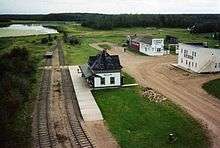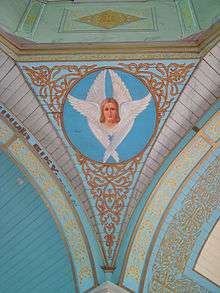Ukrainian Cultural Heritage Village
 | |
| Established | 1974 |
|---|---|
| Location | Lamont County, east of Elk Island National Park, Alberta, Canada |
| Type | open-air, living history |
| Website | www.history.alberta.ca/ukrainianvillage |
The Ukrainian Cultural Heritage Village (Ukrainian: Село спадщини української культури, translit. Selo spadshchyny ukrains’koi kul’tury) is an open-air museum that uses costumed historical interpreters to recreate pioneer settlements in east central Alberta, Canada. In particular it shows the lives of Ukrainian Canadian settlers from the years 1899 to 1930. Buildings from surrounding communities have been moved to the historic site and restored to various years within the first part of the twentieth century.
"The Village", as it is colloquially known, has a very strong commitment to historical authenticity and the concept of living history. The Village uses a technique known as first-person interpretation which requires that the costumed performers remain in character at all times (or as much as is feasibly possible). Actors answer all questions as if it is the year their building portrays. Although this technique is off-putting for some visitors at first, it allows for a much stronger experience of immersion in history than traditional third-person interpretation where the actor acknowledges that he is, in fact, in a museum.

The village is in Lamont County on the Yellowhead highway, on the eastern edge of Elk Island National Park.
Monuments
- Alberta Centenary Pioneer Monument and Centennial Orchard[1]
- Cenotaph to the Ukrainian Canadian Soldier[2]
- Joseph Oleskow Monument – by Leo Mol
- Pioneer Family Monument – by Leo Mol
- Statue of Vasyl' Stefanyk[3]
- Ukrainian Canadian Internment Camp Monument[4]
Buildings
The Historic Site is divided into thematic areas: the Overview, the Farmsteads, the Rural Community, and the railway-centred Town site.
Note: the spellings used for names and locations are those from the year the building portrays, and may not match those in use today
Name (indicates family name of original owners or name of original town location) and year restored to:
Overview
Provides an introduction to Galician and Bukovynian immigration to Canada by showing the homes of three important settler families. Iwan Pylypow was the first Ukrainian immigrant to Canada; his third house in Canada is preserved here. His family was Galician. The second house is that of Mykhailo Hawreliak – the Hawreliaks were a large Ukrainian Bukovynian family who settled in the Shandro area. By the 1920s Mykhailo Hawreliak was quite successful, and the house preserved here has five bedrooms and a cistern that provided rainwater to the kitchen.[5] The cousin of the owner of this house, William Hawrelak, later became the first Ukrainian Canadian mayor of Edmonton. The Nazar Yurko family was also from Bukovyna, but was of Romanian descent. Their grandson, William Yurko, became a member of cabinet in the Alberta government in the 1970s.[6]
- Pylypow House (Edna-Star, Alberta; 1926–28)
- Hawreliak House (Shandro, Alberta; 1927)
- Yurko House (Boian, Alberta; 1930)
Farmsteads

Shows different farmyards from different eras/stages of development.
The newly arrived immigrants
- Burdei – a dugout-style shelter, somewhat between a sod house and log cabin (re-creation, circa 1900)[7]
The Bukovynian settlers
- Grekul House (1918–1919)
- Grekul Granary (1918–1919)
- Roswiyczuk Granary (1918)
- Makowichuk Barn (1918)
The Galician settlers
(under development)
- Lakusta Barn (1918)
- Lakusta Granary (1918)
The later immigrants
- Slemko House (1919)
- Slemko Granary (1919)
- Slemko Barn (1919)
Ukrainian-Canadian farmers
- Kitt Threshing Machine Shed (1930)
- Chernochan Machine Shed (1925–28)[8]
Rural community (reflecting 1925–30 time period)
- Roadside Shrine
- Luzan Grocery (Luzan, Alberta; 1927[9])
- Kiew Hall – a community centre; originally independent, later (1930s) affiliated with the Ukrainian Labour Farmer Temple Association (Kiew, Alberta; 1930)
- St. Nicholas Russo-Greek Orthodox Church[10] (Kiew, Alberta; 1925–30)
- Kolody Sawmill (Vilna, Alberta; 1929)
- "Russia"[11] School and Barn (Musidora, Alberta; 1927)
- St. Nicholas Ukrainian Greek Catholic Church (also known as St. Mary's or Hlus' Church, Buchach, Alberta; 1928)
Town site (reflecting 1925–30 time period)

- St. Vladimir's Ukrainian Greek Orthodox Church (Vegreville, Alberta; 1934)
- Wostok Hardware Store (Wostok, Alberta; 1937)
- Market Square
- Radway Livery Barn (Radway, Alberta; 1929)
- Pawlenchuk Lot Barn (1930)
- Andrew Alberta Provincial Police Post (Andrew, Alberta; 1927–28)
- Bellis Home Grain Co. Elevator (Bellis, Alberta; 1929)
- Bellis Canadian National Railway Station (1928)
- Hilliard Hotel (Hilliard, Alberta; 1929)
- Alberta Lumber Co. Office and Yard (Lamont, Alberta; 1928)
- Demchuk Blacksmith Shop (Myrnam, Alberta; 1929)
- Demchuk House (1929)
- Woodworking Shop (circa 1930)
Affiliations
The Museum is affiliated with: CMA, CHIN, and Virtual Museum of Canada.
See also
- Kalyna Country – an ecomuseum region, of which the village is a part
- List of Canadian place names of Ukrainian origin – some of the places where the Village's buildings and machines are from are listed on this page (in the Alberta section)
References
- ↑ Erected by the Ukrainian Self-Reliance League.
- ↑ Erected by the Edmonton Norwood Branch of the Royal Canadian Legion. See also Canadian Expeditionary Force, History of the Royal Canadian Navy, History of the Canadian Army and History of the Royal Canadian Air Force.
- ↑ Erected by the Association of United Ukrainian Canadians.
- ↑ Erected by the Ukrainian Canadian Civil Liberties Association. See also www.uccla.ca.
- ↑ see also Rainwater harvesting.
- ↑ see also Alberta general election, 1971 and 1975; 17th Alberta Legislative Assembly (1971-75) and 18th Alberta Legislative Assembly (1975-79); and Edmonton-Gold Bar.
- ↑ An original construction of the Village re-creating the first shelters established by the pioneers.
- ↑ Built by Kosma Chernochan in 1917, was one of the first machine sheds in the region. See Maryn, Sonia (1985). The Chernochan machine shed : a land use and structural history. Edmonton: Alberta Culture. p. iv.
- ↑ Choriawy, Cathy (1989). Commerce in the country : a land use and structural history of the Luzan grocery store. Edmonton: Alberta Culture, Historical Resources Division. p. 39.
- ↑ see also Ukrainian Russophiles.
- ↑ see also Rus (name)#From Rus to Ukraine.
External links
- Alberta Community Development – Ukrainian Cultural Heritage Village
- University of Alberta – Ukrainian Cultural Heritage Village
- Google Map to Ukrainian Cultural Heritage Village from Edmonton, Alberta, Canada Route Map Overhead view
| Wikimedia Commons has media related to Ukrainian Cultural Heritage Village. |
Coordinates: 53°34′7″N 112°47′56″W / 53.56861°N 112.79889°W
